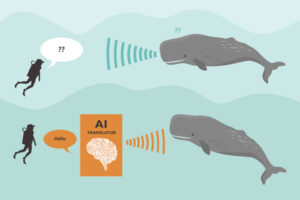Parents and students are attracted to 3-year bachelor degrees, but can institutions make the business model work?
September 23, 2025 BlogDifferentiation is going to be critical for colleges and universities to compete, and more than 60 are now…
Soon, AI will be able to talk to whales.
Yet, for those working in marine mammal conservation, the advent of baleen-communicating AI – science fiction becoming science fact – will not mean that organizations like Save the Whales will become obsolete.
Rather, how conservationists advocate for protecting and preserving whales will change dramatically. Humans’ understanding of animals’ experiences of the world, our ability to better predict migratory patterns, and potentially our empathy for them, will impact conservation efforts.

Using AI to translate whale communication. Artificial intelligence decoding sperm whale coda. Human talking to whale.
As with the advent of any disruptive technology, organizations that quickly figure out how to take advantage of AI, even on a topic as seemingly analog as whale conservation, will surpass those that do not. These tectonic shifts have big implications for the philanthropists that fund these organizations. Funders need to think about how their grantees’ necessary adaptations affect their portfolio and their portfolio strategy.
In Part I of our AI and Philanthropy series, we focused on 3 questions education philanthropists must ask to assess their strategy in the AI era:
In this blog post, we focus on questions funders should seek to answer when evaluating their portfolio strategy in the age of AI.
One of the most immediate impacts of AI will be felt in the labor force. AI is making the workforce more efficient. A recent joint study from Harvard Business School, Wharton, and MIT sought to measure the effects of Generative AI on productivity, finding that workers using AI completed more tasks more quickly and with higher quality than those who did not.
With the pace of such change, workforce development nonprofits need to adapt quickly, developing new programs and going to market at a pace that meets employers’ rapidly changing demands.
 How funders can evaluate grantees
How funders can evaluate granteesIn such a scenario, what role do philanthropists need to play in encouraging and enabling their portfolios to stay ahead of the curve? How should funders measure the AI aptitude of current and future grantees? Evaluating grantees’ ability to leverage new technologies to address new challenges is essential, so funders should consider evaluating grantees in ways that focus on the rapid pace of change:
If not, grantees may not be equipped to thrive and compete in a post-AI world
 AI can accomplish tasks and find patterns that are otherwise invisible to people, and the next AI-enabled breakthroughs in education may profoundly change the field. Researchers have trained AI to:
AI can accomplish tasks and find patterns that are otherwise invisible to people, and the next AI-enabled breakthroughs in education may profoundly change the field. Researchers have trained AI to:
We are seeing the impact core integrations of AI can make in other industries. Soon, these innovations will abound in education. How long will it be until an artificial intelligence analyzes student reading patterns to personalize not only content but methods of instruction? Or one creates a math curriculum that doubles the impact of its closest human-made competitor? What role will AI have in solving the two-sigma problem, and how will nonprofit tutoring providers need to adapt?
Helping grantees drive these innovations or adding grantees to their portfolios working on these breakthroughs is vital for philanthropists moving forward.
AI will introduce new efficiencies and breakthroughs, so philanthropists need to reinterrogate their portfolios and theories of change to align with the evolving ecosystem of their grantees.
Along with these changes, philanthropists may want to update their theories of change to align more closely with the challenges and opportunities of an AI-driven world.
Your grantees’ businesses may change drastically in the next 5-10 years because of AI, as might the composition of the grantees in your portfolio. The future that philanthropists and their grantees strive for may not change dramatically, but the pathway toward the future may have changed forever.
By addressing these challenges head-on along your philanthropic journey, you can assure you and your current and future grantees can drive positive change in a rapidly changing world.
We are always happy to discuss as you and your organization think through these challenges and opportunities. Reach out to have a conversation.
In our next post in our AI series, we will tackle how AI might change the way grant-making as a process is conducted. And in case you missed it, we encourage you to check out part one of our AI series on how AI will disrupt philanthropy.